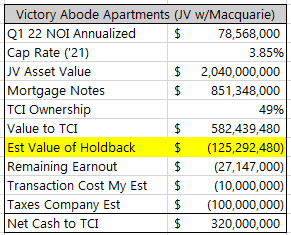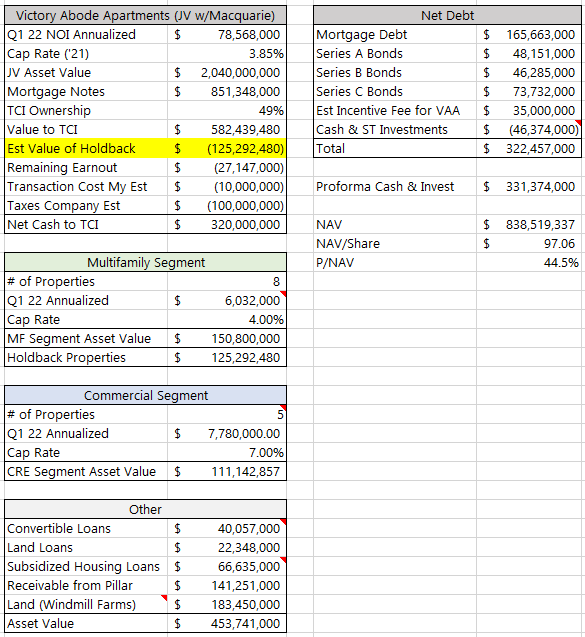Over the weekend, news came out that Transcontinental Realty Investors (TCI) and their partner, Macquarie, sold the assets inside their Victory Abode Apartments joint venture for a total of $2.04B (which was the original thesis from my December 2021 post for some background). On an annualized Q1 2022 NOI basis the sale was done at a 3.85% cap rate, on a forward basis it is probably a bit above 4% as rents are resetting considerably higher in this sunbelt portfolio. Given the current economic backdrop, that price seems like a great exit for TCI as I was nervous shareholders would be disappointed with no sale or one around the recent $1.4B appraised value (as disclosed on p13 of their recent 10-Q). The sale is a bit complicated in that 53 properties were sold in total with 7 of those properties being sold back to TCI at the same valuation as the rest of the portfolio. After paying off mortgage debt and transaction fees, TCI expects to net $320MM in cash from the sale after $100MM they’ve earmarked for taxes.
The sale is expected to close within 75 days (~early September), post deal closing TCI will screen extremely cheap on a price to book basis as their equity VAA joint venture is being carried on the books for $50.6MM while they’re netting $320MM in cash plus the value of the 7 holdback properties, that delta in my estimation almost doubles the book from $45/share to $86/share. Shares trade for around $43, even after the sale announcement, about 50% of proforma book value.
The sale press release gives limited details, but using the Q1 10-Q and some swag math, we can back into the value of the 7 holdback properties.
A $2.04B topline price tag, minus the $851MM of mortgage debt, nets $582+MM in value to TCI. Then backing out the remaining earnout owed to Macquarie, some transactional costs and the company’s estimate of taxes, the plug to get to $320MM is about $125MM in value for the holdback properties. I’m probably off there, so as always, correct me if I made any major mistakes.
Then Pillar, the external manager owned by the controlling shareholders, is due an incentive fee for the capital gains related to the VAA sale, the math is challenging and difficult to model out, but they’re due 10% of any capital gains above a 8% annualized hurdle rate. TCI estimates their tax rate at 21%, if the company’s estimate of $100MM in taxes is accurate, let’s just guess the incentive fee is roughly $35MM for our purposes.
With some simple math, adding the net cash to TCI, estimated value of the holdback properties, subtracting out the incentive fee and the previous carrying value of the JV partnership. I get the below proforma book value.
Once Q3 earnings come out and book value is reported (November time frame if it closes in Q3), maybe some quantitative strategies take notice?
Of course, book value tends to understate the value of real estate companies due to depreciation and historical cost factors. Below I’ve taken most of TCI’s balance sheet and pulled it apart, I’m missing a couple things in their restricted cash and their other assets, there’s limit disclosure around those two line items. I’ve put market multiples on the multifamily and commercial segments, grossed up their land at their Windmill Farms development to approximately equal what the going rate for their acreage has been recently. I get a little under $100/share in NAV, which is probably on the conservative side.
One potential source of hidden value is in their convertible loans, here they lend money to developers with the option to convert the loan to 100% equity ownership in the properties. The terms aren’t disclosed but 6 of the 9 development loans in that bucket are on stabilized assets.
But the big question remains, what will TCI do with the proceeds from the asset sale? In the press release, the company says:
the Company intends to use of most of the cash flow it will receive from the aforesaid in subsection 3 above to make new investments and to expand its multifamily residential property portfolio.
Other thoughts/items:
- Yes, this is externally managed, there’s a 0.75% management fee on gross assets plus a 10% fee on net income and capital gains. Not super shareholder friendly, but they’re really only grifting on the 15% of minority shareholders. I don’t see a lot of benefit to them staying public even with the management fee structure, they haven’t attempted to grow (they don’t even issue shares to themselves, share count has remained steady over the years), there’s public company costs that they’re bearing (on three different levels, ARL, TCI, IOR), it would seem to make the most sense to take advantage of the big discount in the market by tendering for the remaining float.
- The corporate structure here is really confusing, almost all of TCI’s assets are in the Southern Properties Capital entity that was created to issue bonds in Tel Aviv. The commercial properties, the remaining and holdback multi-family properties, all should provide plenty of collateral to back the outstanding Israeli bonds giving them liquidity to do a tender offer.
- ARL and TCI are both entering the Russell 2000 on Friday. ARL traded strangely for a while, trading well above parity with TCI, I switched from ARL to TCI, but it is worth monitoring both of them in the future. I’m guessing most of the index buying has taken place ahead of the reconstitution but given the extremely low float (what a dumb index that would include either of these at their full market cap!) we could see some strange price action.
- One lazy error in my back of the envelope model — one of the properties in the wholly owned multi-family segment was included in the asset sale, so there’s likely a tiny bit of double counting, but shouldn’t be too material. There’s limited disclosure to parse apart, so I just ignored it.
Disclosure: I own shares of TCI





